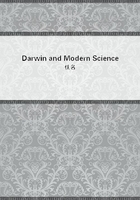
第102章
Here our analogy of a machine which only works in one way seems to fail us, for these bud-sports do not appear in all parts of the organism, only in certain buds or parts of it, so that one part of the zygotic machine would appear to work differently to another. To discuss this question further would take us too far from our subject. Suffice it to say that we cannot answer it, any more than we can this further question of burning interest at the present day, viz. to what extent and in what manner is the machine itself altered by the particular way in which it is worked. In connection with this question we can only submit one consideration: the zygotic machine can, by its nature, only work once, so that any alteration in it can only be ascertained by studying the replicas of it which are produced in the reproductive organs.
It is a peculiarity that the result which we call the ripening of the generative organs nearly always appears among the final products of the action of the zygotic machine. It is remarkable that this should be the case. What is the reason of it? The late appearance of functional reproductive organs is almost a universal law, and the explanation of it is suggested by expressing the law in another way, viz. that the machine is almost always so constituted that it ceases to work efficiently soon after the reproductive organs have sufficiently discharged their function. Why this should occur we cannot explain: it is an ultimate fact of nature, and cannot be included in any wider category. The period during which the reproductive organs can act may be short as in ephemerids or long as in man and trees, and there is no reason to suppose that their action damages the vital machinery, though sometimes, as in the case of annual plants (Metschnikoff), it may incidentally do so; but, long or short, the cessation of their actions is always a prelude to the end. When they and their action are impaired, the organism ceases to react with precision to the environment, and the organism as a whole undergoes retrogressive changes.
It has been pointed out above that there is reason to believe that at the dawn of life the life-cycle was, EITHER IN ESSE OR IN POSSE, at least as long as it is at the present time. The qualification implied by the words in italics is necessary, for it is clearly possible that the external conditions then existing were not suitable for the production of all the stages of the potential life-history, and that what we call organic evolution has consisted in a gradual evolution of new environments to which the organism's innate capacity of change has enabled it to adapt itself.
We have warrant for this possibility in the case of the Axolotl and in other similar cases of neoteny. And these cases further bring home to us the fact, to which I have already referred, that the full development of the functional reproductive organs is nearly always associated with the final stages of the life-history.
On this view of the succession of characters in the life-history of organisms, how shall we explain the undoubted fact that the development of buds hardly ever presents any phenomena corresponding to the embryonic and larval changes? The reason is clearly this, that budding usually occurs after the embryonic stage is past; when the characters of embryonic life have been worked out by the machine. When it takes place at an early stage in embryonic life, as it does in cases of so-called embryonic fission, the product shows, either partly or entirely, phenomena similar to those of embryonic development. The only case known to me in which budding by the adult is accompanied by morphological features similar to those displayed by embryos is furnished by the budding of the medusiform spore-sacs of hydrozoon polyps. But this case is exceptional, for here we have to do with an attempt, which fails, to form a free-swimming organism, the medusa;and the vestiges which appear in the buds are the umbrella-cavity, marginal tentacles, circular canal, etc., of the medusa arrested in development.